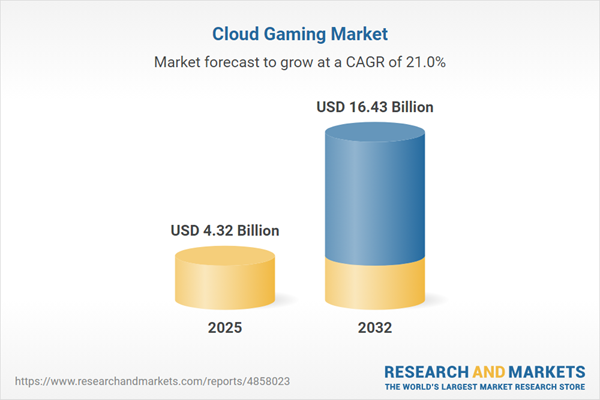Speak directly to the analyst to clarify any post sales queries you may have.
Cloud gaming is rapidly changing enterprise digital strategy, offering senior decision-makers new tools to enhance delivery, streamline operations, and respond to user demands within a shifting market environment. As organizations evaluate adoption and growth in this sector, a strategic approach helps ensure resilience and competitive positioning.
Cloud Gaming Market Snapshot
In 2024, the global cloud gaming market reached USD 3.57 billion, with forecasts suggesting growth to USD 4.32 billion by 2025 and a compound annual growth rate of 21 percent. This expansion is influenced by rising 5G connectivity, advances in edge computing, and major investments in network infrastructures. Providers are responding to the need for wider access by upgrading legacy systems, enabling content delivery to newer user segments. As digital transformation accelerates across industries, leaders must anticipate regulatory changes, intensifying competition, and varied regional requirements—all contributing to a dynamic business landscape and setting new expectations for cloud-based service delivery.
Scope & Segmentation of the Cloud Gaming Market
- Device Types: Cloud gaming solutions are now accessible on consoles, PCs, smart TVs, smartphones, and tablets. This addressing of multiple device types expands organizational reach and supports cost efficiency by reducing dependence on physical hardware upgrades.
- Game Genres: Offerings include action, racing, sports, role-playing, and strategy. These options extend beyond entertainment to enterprise applications, such as immersive workforce training programs and business simulations that foster skills development.
- Monetization Models: Platform operators use advertising, tiered subscriptions, freemium access, and in-game purchases, enabling flexible revenue generation strategies that can adjust to consumer and enterprise expectations.
- End Users: Enterprises leverage cloud gaming for workforce development, advanced simulations, and streamlined software testing. Meanwhile, consumer audiences experience enhanced accessibility to immersive and socially connected gaming content.
- Regional Coverage: North America, Europe, Asia-Pacific, the Middle East, and Africa remain core markets, with the US, Germany, China, India, Brazil, and South Korea facing specific regulations and content requirements. These differences affect rollout strategies and service customization for each territory.
- Companies Profiled: Leading firms such as NVIDIA, Microsoft, Sony Interactive Entertainment, Google, Amazon, Tencent, NetEase, Blacknut, Blade, and Boosteroid demonstrate robust cross-platform integration and scalable cloud-based ecosystems.
- Technology Trends: Adoption of 5G, distributed computing, and open software frameworks is reducing latency and elevating reliability. These advances are key for both enterprise deployments and offerings tailored for individual users, ensuring secure delivery and agile integration capabilities.
Key Takeaways for Senior Decision-Makers
- Forming partnerships with established technology and content providers accelerates access to diverse markets and strengthens business operations on a global scale.
- Revising monetization practices, including expanding subscription tiers and business model diversification, allows adaptation to new user preferences and increases revenue opportunities.
- Scaling distributed infrastructure supports operational continuity and offers consistent, high-quality experiences to both enterprise clients and end users.
- Implementing device-agnostic solutions encourages strong user engagement and facilitates seamless integration across multiple platforms and operating systems.
- Developing targeted content for workforce applications, such as employee training or advanced simulation, enables differentiation and supports enterprise innovation goals.
- Staying alert to evolving technology standards and market signals helps organizations proactively refine their service models and align with shifting user expectations.
Tariff Impact and Supply Chain Shifts
Recent US tariff changes are prompting cloud gaming providers to reassess sourcing and compliance strategies. Many are strengthening regional partnerships and local procurement to navigate regulatory shifts and defend supply continuity in the face of changing international trade conditions.
Market Research Methodology & Data Sources
This report is informed by in-depth executive interviews and expert workshops, alongside benchmarking against recognized standards in networking and data center operations. Industry regulatory reviews and leading sector publications guide analysis of technology adoption and business model trends.
Why This Report Matters
- Enables effective management of digital transformation, helping organizations align compliance and resource allocation as regulatory requirements evolve.
- Offers strategic direction to support robust supply chains and manage risk in digital media and entertainment ecosystems.
- Clarifies segment distinctions and technology trends, supporting informed decision-making and strengthening operational resilience for enterprise leaders.
Conclusion
Long-term competitiveness in the cloud gaming industry depends on agile technology integration and a versatile supply network. Enterprises that focus on adaptable, user-focused offerings and build strong partnerships will be positioned to thrive amid ongoing sector change.
Additional Product Information:
- Purchase of this report includes 1 year online access with quarterly updates.
- This report can be updated on request. Please contact our Customer Experience team using the Ask a Question widget on our website.
Table of Contents
3. Executive Summary
4. Market Overview
7. Cumulative Impact of Artificial Intelligence 2025
Companies Mentioned
The companies profiled in this Cloud Gaming market report include:- NVIDIA Corporation
- Microsoft Corporation
- Sony Interactive Entertainment LLC
- Google LLC by Alphabet Inc.
- Amazon.com, Inc.
- Tencent Holdings Limited
- NetEase, Inc.
- Blacknut SAS
- Blade SAS
- Boosteroid SRL
Table Information
| Report Attribute | Details |
|---|---|
| No. of Pages | 198 |
| Published | October 2025 |
| Forecast Period | 2025 - 2032 |
| Estimated Market Value ( USD | $ 4.32 Billion |
| Forecasted Market Value ( USD | $ 16.43 Billion |
| Compound Annual Growth Rate | 21.0% |
| Regions Covered | Global |
| No. of Companies Mentioned | 11 |









